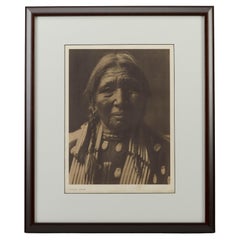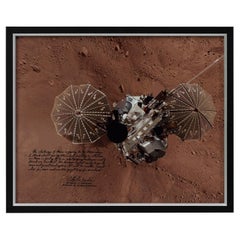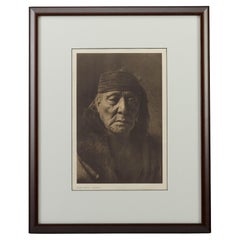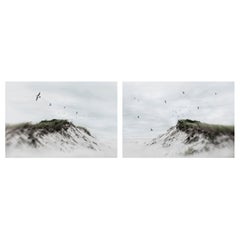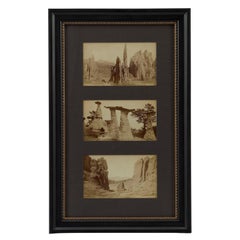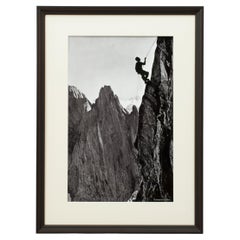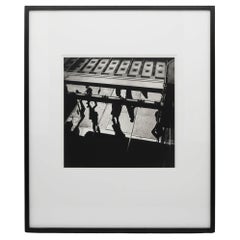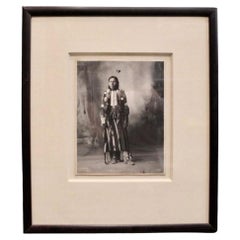Colorado - Photography
to
1,352
1,121
6
6
2
Height
to
Width
to
7
3
3
8
2
1
2
1
8
6
6
6
5
14
14
14
8
14
6
2
Item Ships From: Colorado
"Ogalala Woman" by Edward S. Curtis, 1908
By Edward S. Curtis, 1868-1952
Located in Colorado Springs, CO
Presented is a fine photogravure portrait of an Ogalala woman by Edward Curtis. The image is Plate 94 from Supplementary Portfolio 3 of Edward Curtis' epic project The North American Indian. The caption provided by Curtis for this image is “A face so strong that it is almost masculine, showing strikingly how slight may be the difference between the male and female physiognomy in some Primitive people.” The photograph was taken in 1907 and the photogravure was published in 1908 by John Andrew & Son, in Boston.
Edward S. Curtis created one of the most enduring and iconic visual records in the history of the photographic medium. He was an award-winning artist, a consummate craftsman, a visionary, an intrepid entrepreneur, and was highly regarded as a respected ethnographer and publisher.
Curtis began photographing Native Americans in the mid-1890s and selling these images in his successful Downtown Seattle studio. One of his earliest models was Princess Angeline, the aged daughter of chief Sealth, the Suquamish Indian after whom Seattle is named. At the National Photographic Convention of 1899 Curtis was awarded the grand prize for three of his soft-focused, sepia-toned images of Puget Sound Native Americans: Evening on the Sound, The Clam Digger, and The Mussel Gatherer.
Curtis spent the summer of 1900 with George Bird Grinnell observing the Sun Dance at an encampment of Blood, Blackfeet, and Algonquin in Montana. This was a pivotal experience for Curtis, confirming his desire to study and photograph the Native tribes of North America. A trip to visit the Hopi reservation in Arizona a few months later further fueled his enthusiasm. Curtis envisioned a plan to create a massive scholarly and artistic work that would document the tribes west of the Mississippi, their ceremonies, beliefs, daily life, and landscapes.
In 1906, Curtis approached railroad tycoon J.P. Morgan to request financial assistance for his project. Morgan agreed to pay him a total of $75,000, or $15,000 a year for five years. Morgan and Curtis decided that Curtis' masterwork, The North American Indian, would be a set of 20 volumes of ethnographic text illustrated with high quality photoengravings taken from his glass plate negatives. Each of these volumes would be accompanied by a portfolio of large Size images, all sumptuously bound in Moroccan leather. The papers used for printing would also be of the best quality: a Dutch etching stock by Van Gelder, a Japanese vellum, and for the most discerning subscribers, a translucent Japanese tissue paper. To fund publication, Curtis would sell subscriptions at approximately $3,000 per set, with a total of 500 sets to be published.
An ambitious and extensive project, Curtis spent much of his life documenting as many Native tribes as possible. The importance and the urgency of the task was clear to him, as he wrote in the introduction to his first volume of The North American Indians in 1907, "The information that is to be gathered . respecting the mode of life of one of the great races of mankind, must be collected at once or the opportunity will be lost." In 1930, some 24 years after his initial request for funding, the last two volumes, Vol. 19 and Vol. 20, were published and The North American Indian project was finally completed. Curtis took over 40,000 photographs and made over 10,000 wax cylinder...
Category
Early 1900s American Antique Colorado - Photography
Materials
Paper
Charlie Duke Signed Photograph of the Phoenix Lander on Mars
Located in Colorado Springs, CO
Presented is a photograph of the Phoenix Lander on Mars, signed and inscribed by Apollo 16 moonwalker Charlie Duke. In the inscription, Duke shares his thoug...
Category
Early 2000s American Colorado - Photography
Materials
Paper
"Bear's Teeth - Arikara" by Edward S. Curtis, 1908
By Edward S. Curtis, 1868-1952
Located in Colorado Springs, CO
Presented is a fine photogravure portrait of Bear’s Teeth of the Arikara tribe by Edward Curtis. The image is Plate 154 from Supplementary Portfolio 5 of Edward Curtis' epic project The North American Indian. The caption, written by Curtis, for this image is as follows: “A member of the Night order of the medicine fraternity.” This photogravure was published in 1908 and was printed by John Andrew & Son, in Boston.
Edward S. Curtis created one of the most enduring and iconic visual records in the history of the photographic medium. He was an award-winning artist, a consummate craftsman, a visionary, an intrepid entrepreneur, and was highly regarded as a respected ethnographer and publisher.
Curtis began photographing Native Americans in the mid-1890s and selling these images in his successful downtown Seattle studio. One of his earliest models was Princess Angeline, the aged daughter of chief Sealth, the Suquamish Indian after whom Seattle is named. At the National Photographic Convention of 1899 Curtis was awarded the grand prize for three of his soft-focused, sepia-toned images of Puget Sound Native Americans: Evening on the Sound, The Clam Digger, and The Mussel Gatherer.
Curtis spent the summer of 1900 with George Bird Grinnell observing the Sun Dance at an encampment of Blood, Blackfeet, and Algonquin in Montana. This was a pivotal experience for Curtis, confirming his desire to study and photograph the Native tribes of North America. A trip to visit the Hopi reservation in Arizona a few months later further fueled his enthusiasm. Curtis envisioned a plan to create a massive scholarly and artistic work that would document the tribes west of the Mississippi, their ceremonies, beliefs, daily life, and landscapes.
In 1906, Curtis approached railroad tycoon J.P. Morgan to request financial assistance for his project. Morgan agreed to pay him a total of $75,000, or $15,000 a year for five years. Morgan and Curtis decided that Curtis' masterwork, The North American Indian, would be a set of 20 volumes of ethnographic text illustrated with high quality photoengravings taken from his glass plate negatives. Each of these volumes would be accompanied by a portfolio of large size images, all sumptuously bound in Moroccan leather. The papers used for printing would also be of the best quality: a Dutch etching stock by Van Gelder, a Japanese vellum, and for the most discerning subscribers, a translucent Japanese tissue paper. To fund publication, Curtis would sell subscriptions at approximately $3,000 per set, with a total of 500 sets to be published.
An ambitious and extensive project, Curtis spent much of his life documenting as many Native tribes as possible. The importance and the urgency of the task was clear to him, as he wrote in the introduction to his first volume of The North American Indians in 1907, "The information that is to be gathered ... respecting the mode of life of one of the great races of mankind, must be collected at once or the opportunity will be lost." In 1930, some 24 years after his initial request for funding, the last two volumes, Vol. 19 and Vol. 20, were published and The North American Indian project was finally completed. Curtis took over 40,000 photographs and made over 10,000 wax...
Category
Early 1900s American Antique Colorado - Photography
Materials
Paper
Charlie Duke Signed Photograph of Apollo 16 Moonwalk
Located in Colorado Springs, CO
Presented is an Apollo 16 mission photograph, signed and inscribed by Apollo 16 moonwalker Charlie Duke. The photograph shows Duke collecting lunar samples n...
Category
1970s American Modern Vintage Colorado - Photography
Materials
Paper
Elena Lyakir Diptych, Indian Summer and Learning To Dream Photographs, 2017
By Elena Lyakir
Located in New York, NY
Contemporary New York artist Elena Lyakir's Diptych, Indian Summer and Learning To Dream, were photographed in 2017 and are part of her Aves Series. It's an ongoing exploration of ho...
Category
21st Century and Contemporary American Modern Colorado - Photography
Materials
Aluminum
Vintage Garden of the Gods Postcards by Hook Photo, 1890
Located in Colorado Springs, CO
Presented is a collage of three vintage cabinet card photographs of the Garden of the Gods, in Colorado dating to the 1890s. The sepia toned photo...
Category
1890s American Antique Colorado - Photography
Materials
Paper
Elena Lyakir Wind Photograph, Land and Sea Series, 2008
By Elena Lyakir
Located in New York, NY
Contemporary New York artist Elena Lyakir's Wind was photographed in 2008 and is part of her Land and Sea Series. This is a meditation on the essence of seeing the world through our ...
Category
21st Century and Contemporary American Modern Colorado - Photography
Materials
Aluminum
Solheim Cup Matches U.S. & European Team Signed Photo & Flag, 2009
Located in Colorado Springs, CO
Presented is an autographed collage celebrating the women golfers of the 2009 Solheim Cup U.S. and European teams. The 11th Solheim Cup Matches were held Au...
Category
Early 2000s American Colorado - Photography
Materials
Fabric, Paper
Seven Falls Colorado Springs Antique Photographic Postcard, circa 1880
Located in Colorado Springs, CO
Presented is an antique photographic postcard of Seven Falls, Colorado, from 1880. Postcard production blossomed in the late 1800s and early 1900s, as railroads opened up much of the Western frontier to new and exciting travel opportunities.
Seven Falls is one of Colorado’s most captivating natural wonders. Located at the base of the Front Range, this magnificent series of waterfalls is situated in a 1,250-foot-wall box canyon between the towering Pillars of Hercules and boasts a 181-foot drop of falling water.
Seven Falls was originally part of land given to Nathan Colby in 1872 as part of the Homestead Act of 1862. The Homestead Act granted 160 acres of surveyed land to pioneers in the west, with claimants required to “improve” the plot by building a dwelling and cultivating the land. Mr. Colby promptly sold the track of land to James Hull...
Category
1880s American Antique Colorado - Photography
Materials
Paper
Elena Lyakir Triptych, Feels Like Home. Bridgehampton, NY Photograph, 2016
By Elena Lyakir
Located in New York, NY
Contemporary New York artist Elena Lyakir's Triptych, Feels Like Home. Bridgehampton NY, was photographed in 2016 and is part of her City Parks Romance Series. Elena composed in-came...
Category
21st Century and Contemporary American Modern Colorado - Photography
Materials
Aluminum
Vintage Colorado Springs Postcards by Hook Photo, 1890
Located in Colorado Springs, CO
Presented is a collage of six vintage cabinet card photographs of Colorado Springs and its surrounding areas, dating to the 1890s. The sepia toned...
Category
1890s American Antique Colorado - Photography
Materials
Paper
Elena Lyakir Diptych, Destiny and Fate Photographs, Land and Sea Series, 2013
By Elena Lyakir
Located in New York, NY
Contemporary New York artist Elena Lyakir's Diptych, Destiny and Fate, were photographed in 2013 and are part of her Land and Sea Series. This is a meditation on the essence of seein...
Category
21st Century and Contemporary American Modern Colorado - Photography
Materials
Aluminum
Elena Lyakir Diptych, When We Were Three and The Inevitable Photographs, 2019
By Elena Lyakir
Located in New York, NY
Contemporary New York artist Elena Lyakir's Diptych, When We Were Three and The Inevitable, was photographed in 2019 and are part of her Aves Series. It's an ongoing exploration of h...
Category
21st Century and Contemporary American Modern Colorado - Photography
Materials
Aluminum
Elena Lyakir Where Swallows Hide Photograph, Aves Series, 2017
By Elena Lyakir
Located in New York, NY
Contemporary New York artist Elena Lyakir's Where Swallows Hide was photographed in 2017 and is part of her Aves Series. It's an ongoing exploration of how we relate to the visual ex...
Category
21st Century and Contemporary American Modern Colorado - Photography
Materials
Aluminum
Related Items
Vintage Style Photography, Framed Alpine Ski Photograph, The Climber
Located in Oxfordshire, GB
Vintage style photography, framed alpine ski photograph, Opps!.
'OPPS!', a modern framed and mounted black and white photographic image after an original 1930s skiing photograph. Th...
Category
1930s English Sporting Art Vintage Colorado - Photography
Materials
Paper
$250 / item
H 15.75 in W 21.66 in D 0.89 in
Framed Street Photograph by Vivian Maier Editioned with Provenance
By Vivian Maier
Located in Atlanta, GA
A framed black and white street photograph by Vivian Maier (American, 1926-2009), untitled and undated (circa 1950s), This is a gelatin silver print print...
Category
1950s American Modern Vintage Colorado - Photography
Materials
Wood, Paper
$7,500
H 24.625 in W 20.625 in D 1 in
Vintage Black & White Golf Photograph
Located in Oxfordshire, GB
Late Victorian golf photograph.
A sepia toned late Victorian Colonial golf photograph of a group of male golfers, the group containing a few children. The gentlemen are wearing an assortment of clothing, some in caps, some in bowler hats, a couple with top hats, one gentleman wearing a military uniform with medals. The golf clubs they are holding are early wooden scared head long nose hickory clubs, the sort made by the great Scottish clubmakers like Tom Morris, Willie Park, Alex Patrick, Charlie...
Category
1890s European Sporting Art Antique Colorado - Photography
Materials
Paper
Vintage 1950s Male Original Nude Photo of Brothers Playing Records
By Bruce of Los Angeles
Located in Palm Springs, CA
A rare original b & w photograph of 2 brothers listening to records on the floor nude. Many decades ago we saw a second image from this series and it was listed as the models were brothers. Listening to Les Baxter and Dinah Washington albums! Mid 1950s. I believe the photo to be an “Athletic Model Guild” photo, a competitor of the equally famous, Bruce Bellas aka Bruce of Los Angeles.
The 8x10 photograph has a 11x14 white acid free matt. Ready for framing. If you would like this framed for a gift, we can frame it in a simple black frame for $100. Without a frame, it is easy to be shipped UPS. Makes a great gift for collectors of Male Nude and Beefcake Physique photography. These high quality originals are very difficult to come by. They are NOT computer generated...
Category
1950s American Mid-Century Modern Vintage Colorado - Photography
Materials
Paper
$280 Sale Price
20% Off
H 11 in W 14 in D 0.5 in
Vintage, Antique Alpine Ski Photograph, Davos Parsenn
Located in Oxfordshire, GB
'DAVOS, PARSENN', a new mounted black and white photographic image after an original 1930's skiing photograph. Black & white alpine photos are the perfect addition to any home or ski lodge, so please do check out our other ski photos...
Category
20th Century Swiss Sporting Art Colorado - Photography
Materials
Paper
Vintage Style Photography, Framed Alpine Ski Photograph, The Lift
Located in Oxfordshire, GB
Vintage style Photography, framed Alpine Ski Photograph, the lift.
'THE LIFT', a modern framed and mounted black and white photographic image after an original 1930s skiing photogra...
Category
1930s British Sporting Art Vintage Colorado - Photography
Materials
Paper, Wood
$250 / item
H 21.66 in W 15.75 in D 0.89 in
Edward S. Curtis (1868-1952) Rare Sepia Photogravure Titled Atsina War-Party
By Edward S. Curtis, 1868-1952
Located in Bridgeport, CT
Sepia photogravure titled "Atsina War-Party" depicting Native Americans on their horses over-looking the grasslands in the distance.
The photogravure is titled in plate lower left "A...
Category
20th Century American Rustic Colorado - Photography
Materials
Acrylic, Wood, Paper
$1,295
H 16 in W 17.5 in D 0.75 in
Vintage, Antique Alpine Ski Photograph, Der Sprung
Located in Oxfordshire, GB
Ski photography.
'Der Sprung'', a new mounted black and white photographic image after an original 1930s skiing photograph. Black & white alpine photos are the perfect addition to any home or ski lodge. Prior to being a recreational activity skiing was purely a means of travelling from A to B through the snow, it only started to become the sport it is today in the mid-1800s. The price displayed is for the mounted photo only.
Image size 40cm x 25.5cm = 15 ½" X 10".
The alpine photograph...
Category
Mid-20th Century European Sporting Art Colorado - Photography
Materials
Paper
Vintage Ski Photography, Antique Alpine Ski Photograph, 'OPPS'
Located in Oxfordshire, GB
Vintage Ski Photography, antique Alpine Ski photograph.
'OPPS!', a new mounted black and white photographic image after an original 1930s skiing...
Category
1930s English Sporting Art Vintage Colorado - Photography
Materials
Paper
$93 / item
H 14.97 in W 20.48 in D 0.04 in
Vintage Style Photography, Framed Alpine Ski Photograph, Opps
Located in Oxfordshire, GB
'OPPS!', a modern framed and mounted black and white photograph after an original 1930's skiing photograph. The frame is black with a burgundy undercoat, the glazing is clarity+ prem...
Category
1930s European Sporting Art Vintage Colorado - Photography
Materials
Paper, Wood
$250 / item
H 15.75 in W 21.66 in D 0.89 in
Vintage Alpine Photograph, Climber, Simelistock, Switzerland
Located in Oxfordshire, GB
Vintage photography, antique Alpine mountaineering photograph.
'CLIMBER' Simelistock, Switzerland, a new mounted black and white photographic image after an original 1930s mountaineering photograph. Black and white alpine photos are the perfect addition to any home or ski lodge.
Engelhoerner is the name for a group of limestone mountains that are hidden behind several higher mountains like the Wetterhorn and Wildgerst. These small mountains (Rosenlauistock (2198 m), the Kingspitz, Simelistock, Mittelgruppe, etc.) are well sort after by rock climbers...
Category
1930s British Sporting Art Vintage Colorado - Photography
Materials
Paper
$93 / item
H 20.48 in W 14.97 in D 0.04 in
From The Personal Collection of Audrey Hepburn, Photo by Vincent Rossell, 1962
By Vincent Rossell
Located in Devon, GB
Audrey Hepburn on the set of 'Paris When it Sizzles,' Paris, 1962 by Vincent Rossell
Vintage gelatin silver print
Photographer's credit stamp, Au...
Category
1960s French Mid-Century Modern Vintage Colorado - Photography
Materials
Other
$2,163
H 12.01 in W 9.45 in D 0.01 in
Previously Available Items
1898 “Hubble Big Horse Cheyenne” Photographic Portrait by Frank A. Rinehart
Located in Colorado Springs, CO
Frank Albert Rinehart (February 12, 1861- December 17,1928) was an American artist famous for his drawings, paintings, and photographs depicting Native American personalities and sce...
Category
1890s American Antique Colorado - Photography
Materials
Paper
H 18.75 in W 16.25 in D 1 in
"Horse Capture - Atsina" by Edward S. Curtis, 1908
By Edward S. Curtis, 1868-1952
Located in Colorado Springs, CO
Presented is a fine photogravure portrait of an Atsina man named Horse Capture by Edward Curtis. The image is Plate 170 from Supplementary Portfolio 5 of Edward Curtis' epic project The North American Indian. The photogravure was published in 1908 and was printed by John Andrew & Son, in Boston.
Edward S. Curtis created one of the most enduring and iconic visual records in the history of the photographic medium. He was an award-winning artist, a consummate craftsman, a visionary, an intrepid entrepreneur, and was highly regarded as a respected ethnographer and publisher.
Curtis began photographing Native Americans in the mid-1890s and selling these images in his successful Downtown Seattle studio. One of his earliest models was Princess Angeline, the aged daughter of chief Sealth, the Suquamish Indian after whom Seattle is named. At the National Photographic Convention of 1899 Curtis was awarded the grand prize for three of his soft-focused, sepia-toned images of Puget Sound Native Americans: Evening on the Sound, The Clam Digger, and The Mussel Gatherer.
Curtis spent the summer of 1900 with George Bird Grinnell observing the Sun Dance at an encampment of Blood, Blackfeet, and Algonquin in Montana. This was a pivotal experience for Curtis, confirming his desire to study and photograph the Native tribes of North America. A trip to visit the Hopi reservation in Arizona a few months later further fueled his enthusiasm. Curtis envisioned a plan to create a massive scholarly and artistic work that would document the tribes west of the Mississippi, their ceremonies, beliefs, daily life, and landscapes.
In 1906, Curtis approached railroad tycoon J.P. Morgan to request financial assistance for his project. Morgan agreed to pay him a total of $75,000, or $15,000 a year for five years. Morgan and Curtis decided that Curtis' masterwork, The North American Indian, would be a set of 20 volumes of ethnographic text illustrated with high quality photoengravings taken from his glass plate negatives. Each of these volumes would be accompanied by a portfolio of large Size images, all sumptuously bound in Moroccan leather. The papers used for printing would also be of the best quality: a Dutch etching stock by Van Gelder, a Japanese vellum, and for the most discerning subscribers, a translucent Japanese tissue paper. To fund publication, Curtis would sell subscriptions at approximately $3,000 per set, with a total of 500 sets to be published.
An ambitious and extensive project, Curtis spent much of his life documenting as many Native tribes as possible. The importance and the urgency of the task was clear to him, as he wrote in the introduction to his first volume of The North American Indians in 1907, "The information that is to be gathered . respecting the mode of life of one of the great races of mankind, must be collected at once or the opportunity will be lost." In 1930, some 24 years after his initial request for funding, the last two volumes, Vol. 19 and Vol. 20, were published and The North American Indian project was finally completed. Curtis took over 40,000 photographs and made over 10,000 wax cylinder...
Category
Early 1900s American Antique Colorado - Photography
Materials
Paper
"New Chest, Piegan" by Edward S. Curtis, 1910
By Edward S. Curtis, 1868-1952
Located in Colorado Springs, CO
Presented is a fine photogravure portrait of a Piegan man named New Chest by Edward Curtis. The image is Plate 200 from Supplementary Portfolio 6 of Edward Curtis' epic project The North American Indian. The sixth portfolio volume featured the Piegan, Cheyenne, and Arapaho tribes. The photogravure was published in 1910 and was printed by John Andrew & Son, in Boston.
Edward S. Curtis created one of the most enduring and iconic visual records in the history of the photographic medium. He was an award-winning artist, a consummate craftsman, a visionary, an intrepid entrepreneur, and was highly regarded as a respected ethnographer and publisher.
Curtis began photographing Native Americans in the mid-1890s and selling these images in his successful downtown Seattle studio. One of his earliest models was Princess Angeline, the aged daughter of chief Sealth, the Suquamish Indian after whom Seattle is named. At the National Photographic Convention of 1899 Curtis was awarded the grand prize for three of his soft-focused, sepia-toned images of Puget Sound Native Americans: Evening on the Sound, The Clam Digger, and The Mussel Gatherer.
Curtis spent the summer of 1900 with George Bird Grinnell observing the Sun Dance at an encampment of Blood, Blackfeet, and Algonquin in Montana. This was a pivotal experience for Curtis, confirming his desire to study and photograph the Native tribes of North America. A trip to visit the Hopi reservation in Arizona a few months later further fueled his enthusiasm. Curtis envisioned a plan to create a massive scholarly and artistic work that would document the tribes west of the Mississippi, their ceremonies, beliefs, daily life, and landscapes.
In 1906, Curtis approached railroad tycoon J.P. Morgan to request financial assistance for his project. Morgan agreed to pay him a total of $75,000, or $15,000 a year for five years. Morgan and Curtis decided that Curtis' masterwork, The North American Indian, would be a set of 20 volumes of ethnographic text illustrated with high quality photoengravings taken from his glass plate negatives. Each of these volumes would be accompanied by a portfolio of large size images, all sumptuously bound in Moroccan leather. The papers used for printing would also be of the best quality: a Dutch etching stock by Van Gelder, a Japanese vellum, and for the most discerning subscribers, a translucent Japanese tissue paper. To fund publication, Curtis would sell subscriptions at approximately $3,000 per set, with a total of 500 sets to be published.
An ambitious and extensive project, Curtis spent much of his life documenting as many Native tribes as possible. The importance and the urgency of the task was clear to him, as he wrote in the introduction to his first volume of The North American Indians in 1907, "The information that is to be gathered ... respecting the mode of life of one of the great races of mankind, must be collected at once or the opportunity will be lost." In 1930, some 24 years after his initial request for funding, the last two volumes, Vol. 19 and Vol. 20, were published and The North American Indian project was finally completed. Curtis took over 40,000 photographs and made over 10,000 wax cylinder...
Category
1910s Vintage Colorado - Photography
Materials
Paper
"Porcupine - Cheyenne" by Edward S. Curtis, 1911
By Edward S. Curtis, 1868-1952
Located in Colorado Springs, CO
Presented is a fine photogravure portrait of a Cheyenne man with cottonwood leave headdress by Edward Curtis. The image is Plate 216 from Supplementary Portfolio 6 of Edward Curtis' epic project The North American Indian. The sixth portfolio volume featured the Piegan, Cheyenne, and Arapaho tribes. The caption provided by Curtis for this image is “At the summer gatherings for such occasions as the Sun Dance, the men sometimes protect their heads from the merciless sun by a thatch of cottonwood leaves.” The photogravure was published in 1910 and was printed by John Andrew & Son, in Boston.
Curtis began photographing Native Americans in the Mid-1890s and selling these images in his successful downtown Seattle studio. One of his earliest models was Princess Angeline, the aged daughter of chief Sealth, the Suquamish Indian after whom Seattle is named. At the National Photographic Convention of 1899 Curtis was awarded the grand prize for three of his soft-focused, sepia-toned images of Puget Sound Native Americans: Evening on the Sound, The Clam Digger, and The Mussel Gatherer.
Curtis spent the summer of 1900 with George Bird Grinnell observing the Sun Dance at an encampment of Blood, Blackfeet, and Algonquin in Montana. This was a pivotal experience for Curtis, confirming his desire to study and photograph the Native tribes of North America. A trip to visit the Hopi reservation in Arizona a few months later further fueled his enthusiasm. Curtis envisioned a plan to create a massive scholarly and artistic work that would document the tribes west of the Mississippi, their ceremonies, beliefs, daily life, and landscapes.
In 1906, Curtis approached railroad tycoon J.P. Morgan to request financial assistance for his project. Morgan agreed to pay him a total of $75,000, or $15,000 a year for five years. Morgan and Curtis decided that Curtis' masterwork, The North American Indian, would be a set of 20 volumes of ethnographic text illustrated with high quality photoengravings taken from his glass plate negatives. Each of these volumes would be accompanied by a portfolio of large size images, all sumptuously bound in Moroccan leather. The papers used for printing would also be of the best quality: a Dutch etching stock by Van Gelder, a Japanese vellum, and for the most discerning subscribers, a translucent Japanese tissue paper. To fund publication, Curtis would sell subscriptions at approximately $3,000 per set, with a total of 500 sets to be published.
An ambitious and extensive project, Curtis spent much of his life documenting as many Native tribes as possible. The importance and the urgency of the task was clear to him, as he wrote in the introduction to his first volume of The North American Indians in 1907, "The information that is to be gathered ... respecting the mode of life of one of the great races of mankind, must be collected at once or the opportunity will be lost." In 1930, some 24 years after his initial request for funding, the last two volumes, Vol. 19 and Vol. 20, were published and The North American Indian project was finally completed. Curtis took over 40,000 photographs and made over 10,000 wax...
Category
1910s American Vintage Colorado - Photography
Materials
Paper
Vintage Manitou and Pikes Peak Railway Postcards by Hook Photo, 1890
Located in Colorado Springs, CO
Presented is a collage of three vintage cabinet card photographs of the Manitou and Pikes Peak Railway, in Colorado dating to the 1890s. The sepia...
Category
1890s American Antique Colorado - Photography
Materials
Paper
Robert F. Kennedy Signed and Inscribed Photograph
Located in Colorado Springs, CO
Presented is a signed and inscribed black and white photograph of Robert F. Kennedy. Robert Kennedy is pictured wearing a dark suit and a striped tie. H...
Category
1960s American Mid-Century Modern Vintage Colorado - Photography
Materials
Paper
The Vanishing Race, Signed by Edward S. Curtis, Gelatin Silver Photograph, 1904
By Edward S. Curtis, 1868-1952
Located in Colorado Springs, CO
Presented is an extremely scarce gelatin silver print of The Vanishing Race by Edward S. Curtis. Chosen by Curtis as the first photograph in his epi...
Category
Early 1900s American Antique Colorado - Photography
Materials
Paper
H 24.75 in W 29.75 in D 1 in
Duke Ellington Signed Photograph, 1932
Located in Colorado Springs, CO
Presented is a handsome autographed and inscribed photograph of jazz singer, songwriter, and pianist Duke Ellington, from 1932. Ellington signed and ins...
Category
Early 20th Century Colorado - Photography
Materials
Paper
Original Edward S. Curtis Photogravure, "The Klamath Hunter" 1923
By Edward S. Curtis, 1868-1952
Located in Colorado Springs, CO
Presented is a beautiful photogravure showing a Klamath man hunting from a dugout canoe. This image is Plate 458 from Volume 13 of Edward Curtis' epic project The North American Indian. The photogravure was published in 1923 by Suffolk Engr. Co., in Cambridge, MA. The Klamath people are from the inland region of Northern California and Southern Oregon. Their oral history records the volcanic eruption that created Crater Lake over 7000 years ago
Edward S. Curtis created one of the most enduring and iconic visual records in the history of the photographic medium. He was an award-winning artist, a consummate craftsman, a visionary, an intrepid entrepreneur, and was highly regarded as a respected ethnographer and publisher.
Curtis began photographing Native Americans in the mid-1890s and selling these images in his successful downtown Seattle studio. One of his earliest models was Princess Angeline, the aged daughter of chief Sealth, the Suquamish Indian after whom Seattle is named. At the National Photographic Convention of 1899 Curtis was awarded the grand prize for three of his soft-focused, sepia-toned images of Puget Sound Native Americans: Evening on the Sound, The Clam Digger, and The Mussel Gatherer.
Curtis spent the summer of 1900 with George Bird Grinnell observing the Sun Dance at an encampment of Blood, Blackfeet, and Algonquin in Montana. This was a pivotal experience for Curtis, confirming his desire to study and photograph the Native tribes of North America. A trip to visit the Hopi reservation in Arizona a few months later further fueled his enthusiasm.
Curtis envisioned a plan to create a massive scholarly and artistic work that would document the tribes west of the Mississippi, their ceremonies, beliefs, daily life, and landscapes. In 1906, Curtis approached railroad tycoon J.P. Morgan to request financial assistance for his project. Morgan agreed to pay him a total of $75,000, or $15,000 a year for five years. Morgan and Curtis decided that Curtis' masterwork, The North American Indian, would be a set of 20 volumes of ethnographic text illustrated with high quality photoengravings taken from his glass plate negatives. Each of these volumes would be accompanied by a portfolio of large size images, all sumptuously bound in Moroccan leather. The papers used for printing would also be of the best quality: a Dutch etching stock by Van Gelder, a Japanese vellum, and for the most discerning subscribers, a translucent Japanese tissue paper. To fund publication, Curtis would sell subscriptions at approximately $3,000 per set, with a total of 500 sets to be published.
An ambitious and extensive project, Curtis spent much of his life documenting as many Native tribes as possible. The importance and the urgency of the task was clear to him, as he wrote in the introduction to his first volume of The North American Indians in 1907, "The information that is to be gathered ... respecting the mode of life of one of the great races of mankind, must be collected at once or the opportunity will be lost." In 1930, some 24 years after his initial request for funding, the last two volumes, Vol. 19 and Vol. 20, were published and The North American Indian project was finally completed. Curtis took over 40,000 photographs and made over 10,000 wax cylinder...
Category
1920s American Vintage Colorado - Photography
Materials
Paper
Original Edward S. Curtis, "A Desert Cahuilla Woman, " Photogravure, 1924
By Edward S. Curtis, 1868-1952
Located in Colorado Springs, CO
Presented is a fine photogravure portrait of a young woman of the Cahuilla tribe, from the deserts of Southern California. The image is Plate 522 from Volume 15 of Edward Curtis' epi...
Category
1920s American Vintage Colorado - Photography
Materials
Paper
H 23.25 in W 17.5 in D 0.001 in
Contemporary Spanish Jordi Gomez Sonica Geisha Photography
Located in Aspen, CO
Contemporary Spanish Jordi Gomez Sonica Geisha large scale photograph.
Category
2010s Spanish Colorado - Photography
Materials
Plastic
Vintage 1920s W.H.S Football Team Photograph
Located in Colorado Springs, CO
This is an vintage photograph of a 1927 football team. The team's football is marked "W.H.S. '27" in paint, indicating, presumably, the initials of the team and the year they played ...
Category
1920s American Vintage Colorado - Photography
Materials
Paper
Recently Viewed
View AllMore Ways To Browse
Dutch Bombay
Edwardian Collectors Cabinet
Egyptian Imperial Porphyry
Emile Guillemin Sculptures
Erotic Figurine
Erotic Statue
Faberge Limoge
Faberge Nephrite
Fairfax Silver
Famille Rose Armorial
Faroe Islands
Fat Lava Italy
Federal Mahogany Secretary
Fern Chair
Film Reel
Florentine Lily
Fossil Sink
Four Seasons Cherubs
